Abstract
Herein, we prepare MoS2 and Cu-MoS2 catalysts using the solvothermal method, a widely accepted technique for electrocatalytic overall water-splitting applications. TEM and SEM images, standard tools in materials science, provide a clear view of the morphology of Cu-MoS2. HRTEM analysis, a high-resolution imaging technique, confirms the lattice spacing, lattice plane, and crystal structure of Cu-MoS2. HAADF and corresponding color mapping and advanced imaging techniques reveal the existence of the Cu-doping, Mo, and S elements in Cu-MoS2. Notably, Cu plays a crucial role in improving the hydrogen evolution reaction (HER) and oxygen evolution reaction (OER) of the Cu-MoS2 catalyst as compared with the MoS2 catalyst. In addition, the Cu-MoS2 catalyst demonstrates significantly lower overpotential (167.7 mV and 290 mV) and Tafel slopes (121.5 mV dec−1 and 101.5 mV dec−1), standing at −10 mA cm−2 and 10 mA cm−2 for HER and OER, respectively, compared to the MoS2 catalyst. Additionally, the Cu-MoS2 catalyst displays outstanding stability for 12 h at −10 mA cm−2 of HER and 12 h at 10 mA cm−2 of OER using chronopotentiaometry. Interestingly, the Cu-MoS2‖Cu-MoS2 cell displays a lower cell potential of 1.69 V compared with the MoS2‖MoS2 cell of 1.81 V during overall water splitting. Moreover, the Cu-MoS2‖Cu-MoS2 cell shows excellent stability when using chronopotentiaometry for 18 h at 10 mA cm−2.
1. Introduction
The rapidly growing urban landscape, defense industry, space divisions, and fossil fuel-based transportation sectors are causing global warming and disparities in the ecological system [1]. Therefore, the inescapable energy shortage and ecological concerns due to carbon emissions have unlocked an opportunity for widespread research on alternative energy sources [2,3]. Hydrogen, a widely distributed substance in the universe that is generated from various catalytic nanomaterials, is comprehensively accepted as a favorable energy source with which to substitute fossil fuels [4]. Furthermore, clean and green hydrogen can be achieved using the electrochemical splitting of water, without any further carbon secretion during the hydrogen and oxygen generation process [5]. Therefore, catalytic water splitting is considered an important and vital procedure for harvesting clean hydrogen energy from chemical energy [6], consisting of two half-cell reactions at the cathode (hydrogen evolution reaction, HER) and at the anode (oxygen evolution reaction, OER) [7]. Interestingly, OER provides electrons and protons for a reduction in half-reaction, creating major energy losses due to sluggish reaction kinetics [8]. Remarkably, the OER electrocatalysts with the greatest catalytic activities are precious metals and their oxides, namely Ru, RuO2, IrO2, and Ir [9]. However, the precious metal Pt is considered the standard electrocatalyst for HER, which is expensive and makes hydrogen generation overpriced [10]. Therefore, making progress in developing active, inexpensive, durable, and excellent conductive bifunctional catalysts for the HER and OER is one of the crucial tasks for several electrocatalytic water-splitting technologies. Curiously, numerous nanostructural materials have been studied to examine the capabilities of electrochemical water-splitting activities.
Molybdenum disulfide (MoS2) is a prominent member of the transition metal dichalcogenide (TMD) family that has received noteworthy attention in recent years due to its intriguing physical, optoelectronic, mechanical, and magnetic features, and various potential applications [11]. As a nanolayered material, MoS2 displays an exclusive S-Mo-S sandwich structure, where molybdenum atoms are sandwiched between layers of sulfur atoms, exhibiting an n-type behavior [12,13]. This sandwich structure of the MoS2 divulges resilient edge active sites, which facilitate quick catalytic reaction kinetics, making it a more suitable candidate for electrocatalytic water-splitting technological developments [14]. MoS2 materials are multidimensional and outstanding and well recognized for their excellent optoelectronic, magnetic, mechanical, and ionic properties [15]. MoS2 is an extremely stable nanomaterial with weak van der Waals interactions between the layers and resilient in-plane covalent bonds that enable smooth mechanical exfoliation into thin sheets [16]. Interestingly, the exclusive features of MoS2, exhibited mainly when reduced to a few layers or a monolayer, facilitate its use in next-generation cutting-edge technologies. MoS2 exhibits distinct optical bandgap properties depending on its thickness. The electronic properties of the MoS2 are remarkable due to its switchable nature from an indirect bandgap (bulk form) to a direct bandgap (monolayer), which can be favorable for numerous applications. Moreover, MoS2 has an indirect bandgap of nearly 1.27 eV in the bulk form [17]. Besides, MoS2 displays a direct bandgap of about 1.90 eV in the few-layer or monolayer form [18]. The morphologies of MoS2 can differ significantly based on the synthesis techniques, which tune its properties and appropriateness in different applications. MoS2 can be synthesized in various forms, including nanotubes [19], nanosheets [20], nanoflowers [21], nanowires [14], and nanoribbons [22], each demonstrating unique edge structures, surface areas, and electrolysis water-splitting activities [23]. The morphologies of MoS2 play a decisive role in shaping its capabilities in various applications, such as the electrolysis of water [24], supercapacitors [25], field-effect transistors [26], batteries [27], perovskite light-emitting diode [28], and gas sensors [29]. Numerous production methods have been established to prepare MoS2 with precise morphologies and properties, which include hydrothermal qualities [30], solvothermal qualities [31], sol–gel applications [32], co-precipitation [33], pulse laser deposition [34], DC sputtering [35], and flame spray pyrolysis [36]. Interestingly, the above-discussed techniques offer distinctive benefits in terms of ease, scalability, and the capacity to modify the features of MoS2. Remarkably, chemical synthesis routes, such as hydrothermal and solvothermal approaches, have been extensively used for their capability to synthesize high-purity MoS2 with well-defined morphologies [37,38]. On the other hand, physical synthesis methods, such as RF sputtering and chemical vapor deposition, have been broadly utilized to prepare high-purity MoS2 thin films in vertically aligned morphologies with various applications [39,40]. Despite its prospective applications, MoS2 faces serious limitations, such as slow OER electrocatalytic reaction kinetics, high overpotential, and inadequate stability, which hamper its commercial applicability. Therefore, improving the catalytic performance of MoS2 is imperative for its practical application. Among the various doping materials investigated, copper (Cu) is a hopeful catalytic candidate for advancing the electrochemical activities of the MoS2. Therefore, the Cu-doped MoS2 (Cu-MoS2) boosts ionic interactions, magnifies the surface area, and enables electrical conduction, making it predominantly active in increasing electrocatalytic activities. Therefore, the doping of Cu into MoS2 can build chemically active defect states, which can increase overall conductivity, thereby regulating the overall water-splitting process.
In this work, we investigate the electrocatalytic overall water splitting of the MoS2 and Cu-MoS2 catalysts. Fascinatingly, the MoS2 and Cu-MoS2 catalysts are prepared using a simple, scalable, and inexpensive solvothermal method. Attractively, Cu plays a dynamic role in ornamenting the electrocatalytic overall water-splitting properties of the Cu-MoS2 catalyst. Stimulatingly, the Cu-MoS2 catalyst shows a low overpotential and a low Tafel slope of HER and OER compared to the MoS2 catalyst. Fascinatingly, Cu-MoS2‖Cu-MoS2 cell shows low potential and excellent stability for 18 h at 10 mA cm−2. Moreover, the OER and HER mechanisms are also discussed to study the reaction process of hydrogen and oxygen generation.
2. Synthesis Methods
MoS2 and Cu-MoS2 were prepared using a straightforward one-step solvothermal process. Typically, 60 mL (1:1 ratio) of ethanol and DI water were mixed with 16 mg of C2H5NS and 4 mmol of Na2MoO4·2H2O, while being magnetically stirred to create a consistent solution. Furthermore, 2 mg of Cu was melted in 10 mL of DI water using a combination of magnetic stirring and sonication. Further, using magnetic stirring, 3 mL of the Cu precursor was gradually mixed dropwise into the 60 mL Mo and S precursor solution. The Mo and S precursor solution, mixed with Cu, was then shifted to an autoclave with a capacity of 100 milliliters. Additionally, a 2.2 cm × 3.0 cm portion of washed Ni-foam was put in the autoclave at 180 °C for 18 h to allow Cu-MoS2 to grow in situ on 3D Ni-foam. Finally, the Cu-MoS2 deposited on Ni-foam was washed with ethanol and DI water to remove the impurities and dehydrated at 95 °C under vacuum conditions for 15 h. Similarly, pure MoS2 was also synthesized using the above-discussed method with a Cu source.
The Cu-MoS2 morphology of the Ni-foam is meticulously scanned via a scanning electron microscope (SEM) obtained from S-4800 HITACHI, Ltd., Tokyo, Japan. Additionally, the structural, morphological, and elemental properties of the Cu-MoS2 are thoroughly studied via TEM, HRTEM, and HAADF with elemental mapping using the JEOL, JEM-2100F, JEOL Ltd., Tokyo, Japan. Moreover, the electrocatalytic activities of the MoS2 and Cu-MoS2 catalysts for electrocatalytic water splitting are rigorously tested using the electrochemical workstation VersaSTAT3 (Princeton Applied Research). The electrocatalytic performances of the MoS2 and Cu-MoS2 electrocatalysts are tested via a three-electrode arrangement in a 1.0 M KOH alkaline electrolyte. The MoS2 and Cu-MoS2 catalysts, Pt, and Ag/AgCl are used as working, counter, and reference electrodes, respectively. The overall water splitting is investigated in two-electrode arrangements in 1.0 M KOH, where MoS2 or Cu-MoS2 are used in both anode and cathode electrodes. The linear sweep voltammetry (LSV) of the MoS2 and Cu-MoS2 catalysts are studied at 5 mV s−1. Furthermore, the Tafel slopes of the MoS2 and Cu-MoS2 catalysts are accomplished from the LSV plot, using , where b is the Tafel slope, j is the current density, a is the transfer coefficient, and η is the overpotential. The recorded potential vs. Ag/AgCl is converted into the potential of the reversible hydrogen electrode (RHE) via the relation .
3. Results and Discussions
Figure 1 elucidates the scanning electron microscopy (SEM) visuals of the Cu-MoS2. The shape of the Cu-MoS2 grown on the Ni-foam substrate is shown in Figure 1a,b at different magnifications, exploring the different orientations of the nanolayers. Further, the nanolayered morphology of Cu-MoS2 is described in Figure 1a,b, where the outermost portions of the nanolayers can be seen in various directions, enabling a greater chance for engagement with the alkaline electrolyte, which can be beneficial for improving the electrocatalytic water-splitting activities. Also, the surface area of Cu-MoS2 can be significantly expanded by these multilayered architectures, and thus, these unique nanolayer structures create ideal sites of interaction on the Cu-MoS2 surface for hydrogen and oxygen evolution reaction procedures. Moreover, Cu-doping in Cu-MoS2 boosts the number of engaged reaction sites and their area of interface with the KOH electrolyte, which can enhance the catalytic capabilities of the hydrogen and oxygen evolution reaction. In addition, this unique Cu-MoS2 morphology can also promote the transfer of electrons due to the highly conductive nature of Cu in the Cu-MoS2. However, the surface structure of the Cu-MoS2 also indicates that it is able to transfer hydrogen and oxygen molecules and improve adsorption and desorption to accelerate kinetics for the development of hydrogen and oxygen in overall water splitting.
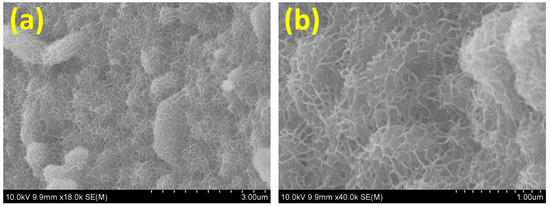
Figure 1.
(a,b) The SEM pictures of the Cu-MoS2 on 3D Ni-foam at different magnifications.
Additionally, Figure 2a,b depict the transmission electron microscopy (TEM) images of the Cu-MoS2 to further study morphology on the nanoscale at different magnifications. It is observed that the synthesized Cu-MoS2 illustrates the agglomerated nanolayers. It is also important that the nanoscale shape of the Cu-MoS2 plays a significant role in the creation of the catalytically active sites on the catalyst surface, which can be beneficial for overall water-splitting applications. Interestingly, crumbled nanolayers of Cu-MoS2 also offer more exposure area for the KOH electrolyte during oxygen, hydrogen, and overall water-splitting tests. Consequently, it is expected that the TEM images will support the SEM results, as depicted in Figure 1. Furthermore, the structural examination of the Cu-MoS2 is studied using high-resolution TEM (HRTEM) and FFT, as portrayed in Figure 3a–e. Figure 3a shows the HRTEM image of the Cu-MoS2, illustrating several small crystallites, which show the lattice fringes of the Cu-MoS2. Interestingly, these small crystallites merge together to form the nanolayers of Cu-MoS2, which have a significant impact on the creation of various lattice strains in the Cu-MoS2 nanolayers. Figure 3b,d display the zoomed portion of the HRTEM image of Cu-MoS2 to reveal 0.265 nm lattice spacing. Figure 3c,e present the FFT images of the Cu-MoS2 from the HRTEM area, as shown in Figure 3b,d. The FFT images of the Cu-MoS2 show the lattice plane (100) corresponding to 0.265 nm lattice spacing. Moreover, the lattice spacing (0.265 nm) and lattice plane (100) of the synthesized Cu-MoS2 are consistent with those of the JCPDS card no. 37-1492, which confirms the hexagonal crystal structure [41]. In addition, to verify the Cu-doping, color mapping of the Cu-MoS2 is performed and the results are shown in Figure 4a–d. Figure 4a reveals the high-angle annular dark field-scanning (HAADF) image of the Cu-MoS2, which is used for the color mapping of Mo, S, and Cu elements. Figure 4b–d exhibit the color mapping of Cu, Mo, and S elements, which confirms the doping of Cu atoms in the Cu-MoS2.
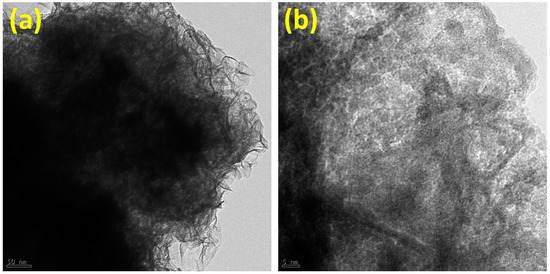
Figure 2.
(a,b) TEM images of the Cu-MoS2 at different magnifications.
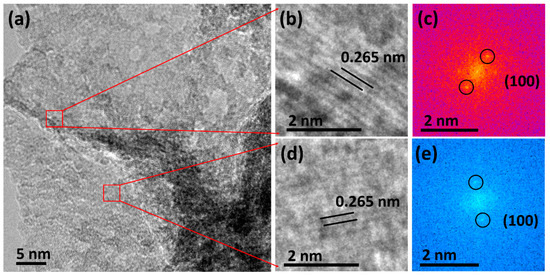
Figure 3.
(a) HRTEM image, (b,d) HRTEM images from the enlarged area, and corresponding (c,e) FFT patterns of the Cu-MoS2.
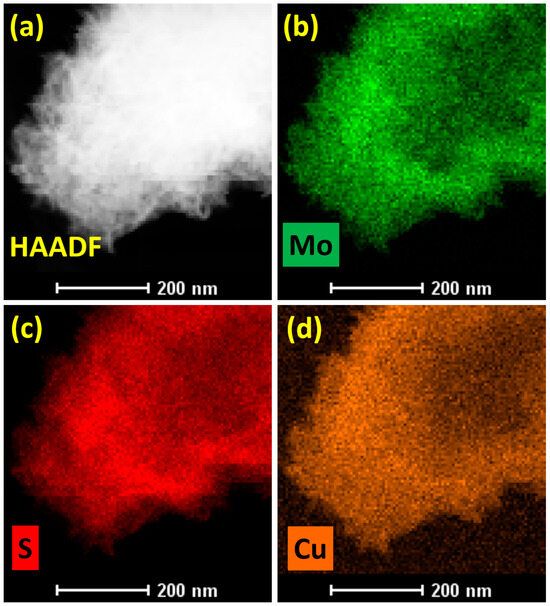
Figure 4.
(a) HAADF image and elemental mapping of (b) Mo, (c) S, and (d) Cu elements of the Cu-MoS2.
The oxygen evolution reaction (OER) has a high energy barrier for its four-electron transfer mechanism, hindering the rate of electrocatalytic reaction kinetics. The electrochemical performance of the MoS2 and Cu-MoS2 electrocatalysts for OER is studied by a three-electrode arrangement in a 1.0 M KOH alkaline medium. Figure 5a depicts the linear sweep voltammetry (LSV) plots, comparing the characteristics of the MoS2 and Cu-MoS2 catalysts at 5 mV s−1. The LSV plots noticeably elucidate that the Cu-MoS2 catalyst reveals remarkably higher OER performances than the MoS2 catalyst. Moreover, Figure 5b divulges the overpotentials of the Cu-MoS2 and MoS2 electrocatalysts. Stimulatingly, the Cu-MoS2 catalyst specifies a smaller overpotential of 290 mV than the MoS2 catalyst of 380 mV. This reduction in the overpotential of the Cu-MoS2 electrocatalyst is due to the doping of Cu, which improves electron transport and favorable adsorption energies and reduces the energy barrier during the OER process [42,43]. Figure 5c elucidates the Tafel plots of the Cu-MoS2 and MoS2 electrocatalysts to examine the reaction rate kinetics. It is observed that the Tafel slope of the Cu-MoS2 electrocatalyst is 101.5 mV dec−1, which is smaller than that of the MoS2 electrocatalyst at 106.3 mV dec−1. In addition, Figure 5d discloses results of a stability test performed to estimate the robustness of the Cu-MoS2 catalyst. It is observed that the initial potential of stability of the Cu-MoS2 catalyst is 1.52 V, which upsurges to 1.54 V after 12 h of the chronopotentiometry test at a current density of 10 mA cm−2. The outstanding stability of the Cu-MoS2 electrocatalyst is due to its various features, such as the strong interaction between the Cu-doping atom and host MoS2, the high surface area, its low susceptibility to structural breakdown, and the decreased deactivation of the active sites on the Cu-MoS2 electrocatalyst surface [44,45]. The structural stability, such as mechanical stress; well-created active sites; lack of significant degradation during the long-term stability test for 12 h; and excellent thermal stability of the nanolayered Cu-MoS2 catalyst were significant [46,47].
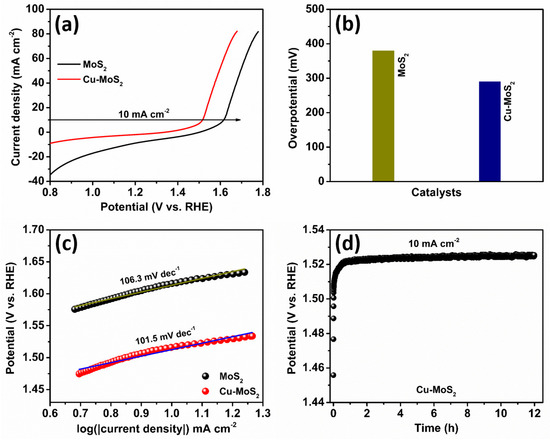
Figure 5.
Electrocatalytic oxygen evolution reaction (OER). (a) LSV plots, (b) overpotential, and (c) Tafel plots of the MoS2 and Cu-MoS2 catalysts. (d) Stability test of the Cu-MoS2 catalyst at 10 mA cm−2 for 12 h.
The HER catalytic activities of the Cu-MoS2 and MoS2 electrocatalysts are investigated using the simple three-electrode process in an alkaline 1.0 M KOH. Figure 6a displays the linear sweep voltammetry (LSV) plots of the MoS2 and Cu-MoS2 catalysts at a scan rate of 5 mV s−1. As depicted in the LSV plots in Figure 6a, the Cu-MoS2 catalyst unveils superior hydrogen evolution activities to the MoS2 catalyst. Interestingly, the onset potential of the Cu-MoS2 catalyst is lower than that of the MoS2 catalyst, which necessitates low energy use to initiate the electrocatalytic hydrogen evolution reaction [48,49]. Therefore, it is expected that the Cu-MoS2 catalyst can offer a greater rate of hydrogen generation than the MoS2 catalyst at the same applied potential. Further, Figure 6b presents overpotential plots of the MoS2 and Cu-MoS2 catalysts, providing vital insight into their electrocatalytic efficiency. The Cu-MoS2 catalyst illustrates a lower overpotential of 167.7 mV than the MoS2 catalyst, which has one of 193.4 mV. It is supposed that the Cu-doping might be responsible for the increased presence of active sites on the Cu-MoS2 electrocatalyst surface [50]. Also, Cu-doping in MoS2 can create structural changes in the electronic properties of the Cu-MoS2 catalyst, leading to reduced overpotential [42]. Fascinatingly, Tafel slopes are vital factors in electrocatalytic hydrogen evolution reactions, offering insightful indications regarding the reaction kinetics and mechanism [51]. Figure 6c elucidates the Tafel plots of the Cu-MoS2 and MoS2 electrocatalysts to examine their reaction rate kinetics and mechanisms. It is observed that the Tafel slope value of the Cu-MoS2 electrocatalyst is lower, at 121.5 mV dec−1, than that of the MoS2 catalyst at 124.4 mV dec−1. This reduces the Tafel slope value of the Cu-MoS2 catalyst, suggesting that low overpotential is necessary to reach −10 mA cm−2. Interestingly, the doping of the Cu atom can increase the electron transfer capability of the Cu-MoS2 electrocatalyst and further lower the energy barrier during the HER process. Moreover, Figure 6d reveals the results of a stability test of the Cu-MoS2 catalyst, performed to inspect its durability at −10 mA cm−2. Using the chronopotentiometry test, it is observed that the initial potential of the Cu-MoS2 electrocatalyst is 166.8 mV, and it reaches up to 173.2 mV after 12 h of stability. Excitingly, it can be the intrinsic properties of the 2D-layered Cu-MoS2 catalyst, such as outstanding chemical stability, surface area, and resistance to corrosion, which influence the adsorption and desorption process during the 12 h stability test [52,53,54].
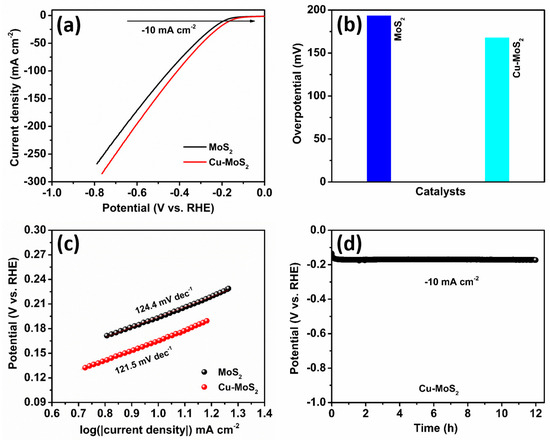
Figure 6.
Electrocatalytic hydrogen evolution reaction (HER). (a) LSV plots, (b) overpotential, and (c) Tafel plots of the MoS2 and Cu-MoS2 catalysts. (d) Stability test of the Cu-MoS2 catalyst at −10 mA cm−2 for 12 h.
Further, we investigated the electrocatalytic activities of the MoS2‖MoS2 cell and Cu-MoS2‖Cu-MoS2 cell in a two-electrode arrangement (overall water splitting) in 1.0 M KOH alkaline. Figure 7a displays the linear sweep voltammetry (LSV) plots of the MoS2‖MoS2 cell and Cu-MoS2‖Cu-MoS2 cell at 5 mV s−1 in overall water splitting. It is observed that Cu-doping in the MoS2 plays a significant role in the shift of the LSV curve toward the low-potential side. Figure 7b displays the cell potential in the overall water splitting of the MoS2‖MoS2 cell and Cu-MoS2‖Cu-MoS2 at 10 mA cm−2. Fascinatingly, the Cu-MoS2‖Cu-MoS2 cell shows a small cell potential of 1.69 V compared to the MoS2‖MoS2 cell’s potential of 1.81 V in overall water splitting. The low cell potential of the Cu-MoS2‖Cu-MoS2 cell compared with MoS2‖MoS2 cell is ascribed to the synergistic influence of Cu-doping in the host MoS2. Curiously, the stability of the MoS2‖MoS2 cell is vital for everyday applications in overall water-splitting applications, where enduring practical productivity is essential. Figure 7c parades the stability results after 18 h of processing the Cu-MoS2‖Cu-MoS2 cell at a 10 mA cm−2 current density in an overall water-splitting process. Using the chronopotentiometry test, it is observed that the cell potential upsurges from 1.726 V to 1.75 V during 18 h of testing at 10 mA cm−2. The inset in Figure 7c shows an optical photograph of the overall water splitting. Remarkably, various factors, including electrolyte composition, conductivity, ion exchange, corrosiveness, impurity atoms, and pH, affect the overall water-splitting durability of the Cu-MoS2‖Cu-MoS2 cell during the 18 h chronopotentiometry test. Furthermore, the doping of the Cu atom in the Cu-MoS2 catalyst its reduces structural degradation over 18 h of stability and enhances its surface chemistry, which can decrease the corrosion of the catalyst, creating excellent synergy between Cu-atom and MoS2 in the Cu-MoS2 catalyst, improving charge-transfer, and reducing the energy required to complete the overall water-splitting reaction [55,56].
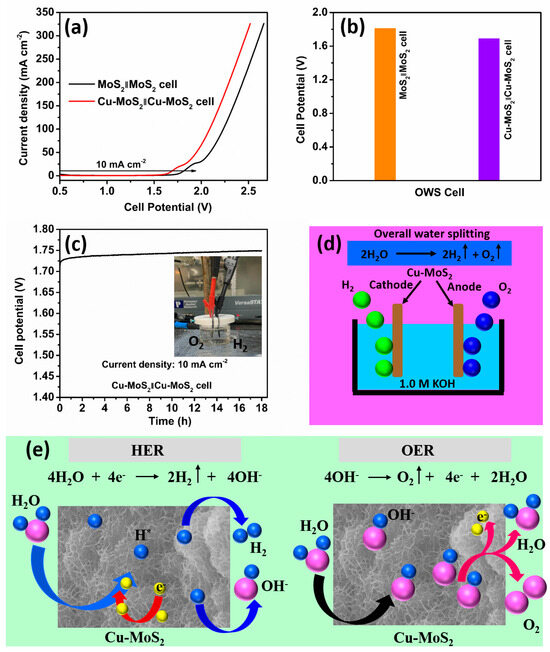
Figure 7.
(a) LSV plots. (b) Cell potentials of the MoS2‖MoS2 cell and Cu-MoS2‖Cu-MoS2 cell. (c) Stability of the Cu-MoS2‖Cu-MoS2 cell at 10 mA cm−2 (inset—optical photograph) and (d) schematic presentation of the overall water-splitting mechanism of the Cu-MoS2‖Cu-MoS2 cell. (e) Schematic depiction of the impact of the HER and OER mechanisms on the Cu-MoS2 catalyst surface.
Further, in the Cu-MoS2‖Cu-MoS2 cell, the water-splitting mechanism implicates both the hydrogen evolution reaction (HER) and oxygen evolution reaction (OER). The HER mechanism is elaborated in the following Equations (1)–(3) [41,57] and illustrated in Figure 7e.
Volmer process:
Heyrovsky process:
Tafel process:
Figure 7e shows the HER mechanism, which follows the Equations (1) and (2) because the Tafel slope value lies in the range of the Heyrovsky process.
Fascinatingly, the oxygen evolution reaction (OER) is sluggish, and it needs to be improved using different variations in the electrocatalysts. Generally, the OER is the adsorption four-electron transfer process. The OER takes place in various steps in alkaline electrolytes, as shown in the following, Equations (4)–(7) [58,59].
In Equation (4), the adsorption of OH– with the active site M onto the Cu-MoS2 electrocatalyst’s surface generates OH and an electron. In Equation (5), the interaction between OH and OH– of the Cu-MoS2 electrocatalyst surface and then the bond-breaking process produce water molecules, oxygen, and an electron. Moreover, the second adsorption process is discussed in Equation (6), which illustrates the intermediate state OOH, making bonds with active site M on the Cu-MoS2 electrocatalyst’s surface. Furthermore, the intermediate state OOH, adsorbed onto the active site M on the Cu-MoS2 surface, further interacts with OH, which produces water molecules, creates oxygen, and releases an electron as discussed in Equation (7). Figure 7d,e exposes the schematic illustration of the overall water splitting of the Cu-MoS2‖Cu-MoS2 cell. Interestingly, the graphic depiction in Figure 7d,e explores the understanding of the electrocatalytic developments occurring at both the anode (Cu-MoS2) and cathode (Cu-MoS2) electrodes in 1.0 M KOH. Unusually, protons from electrolytes are reduced at the cathode (Cu-MoS2) electrode to produce hydrogen energy. However, water molecules are oxidized at the anode (Cu-MoS2) electrode to produce oxygen, protons, and electrons. Moreover, Table 1 lists the electrocatalytic results reported works in the literature for comparison with the present study. The Cu-MoS2 catalyst is observed to be better than or comparable to the reported results.

Table 1.
Comparative study of the electrocatalytic activities of the Cu-MoS2 catalyst with other results reported from the literature.
4. Conclusions
In conclusion, the Cu-MoS2 catalyst, which is synthesized by the simple and scalable solvothermal method, shows remarkable electrocatalytic activities in the overall water-splitting application. The Cu-MoS2 catalyst depicts low overpotential and small Tafel slopes during HER and OER. We also investigate whether the Cu-MoS2 catalyst elucidates the outstanding stability of OER (at 10 mA cm−2) and HER (at −10 mA cm−2) in a three-electrode setup. The Cu-MoS2‖Cu-MoS2 cell illustrates excellent stability for 18 h and a small cell potential of 1.69 V at 10 mA cm−2. Therefore, it is concluded that the Cu-MoS2‖Cu-MoS2 cell shows enhanced electrocatalytic activities due to Cu doping, resulting in a lower cell potential and outstanding stability in overall water splitting, which is crucial for practical applications in renewable energy technologies. Furthermore, variations in the Cu-doping concentration, the Mo and S precursor concentrations, and the solvothermal reaction temperature and time need to be further optimized to tailor the morphology and properties of the Cu-doped MoS2 for various applications, such as in sensors, memory devices, supercapacitors, batteries, and photocatalysis.
Author Contributions
Conceptualization, R.K.M.; Investigation, A.M.T.; Data curation, A.M.T.; Writing—review & editing, A.M.T., R.K.M., J.C.S. and W.J.; Visualization, A.M.T. and R.K.M.; Supervision, J.C.S. and W.J.; Project administration, J.C.S. and W.J.; Funding acquisition, W.J. All authors have read and agreed to the published version of the manuscript.
Funding
This work was supported by the Technology Innovation Program (RS-2023-00235844, Development of nano-structured materials and devices for super steep subthreshold swing), funded by the Ministry of Trade, Industry & Energy (MOTIE, Korea) (1415187621). This work was also financially supported by the National Research Foundation of Korea, South Korea (NRF-2020R1A2C1015206, NRF-2022M3I8A2085429).
Data Availability Statement
The original contributions presented in the study are included in the article, further inquiries can be directed to the corresponding authors.
Conflicts of Interest
The authors declare no conflict of interest.
References
- Gautam, A.; Sk, S.; Pal, U. Recent advances in solution assisted synthesis of transition metal chalcogenides for photo-electrocatalytic hydrogen evolution. Phys. Chem. Chem. Phys. 2022, 24, 20638–20673. [Google Scholar] [CrossRef]
- Raveendran, A.; Chandran, M.; Siddiqui, M.R.; Wabaidur, S.M.; Angaiah, S.; Dhanusuraman, R. Binary Ni–Cu nanocomposite-modified MXene-adorned 3D-nickel foam for effective overall water splitting and supercapacitor applications. Sustainable Energy Fuels 2024, 8, 1509–1525. [Google Scholar] [CrossRef]
- Shaikh, N.; Annadata, H.V.; Mishra, A.K.; Urkude, R.R.; Mukhopadhyay, I.; Ray, A. Doping induced mixed polytypic interfaces of MoS2 for superior electrocatalytic hydrogen evolution. Appl. Surf. Sci. 2024, 649, 159195. [Google Scholar] [CrossRef]
- Zhao, S.; Zhang, C.; Wang, S.; Lu, K.; Wang, B.; Huang, J.; Peng, H.; Li, N.; Liu, M. Photothermally driven decoupling of gas evolution at the solid-liquid interface for boosted photocatalytic hydrogen production. Nanoscale 2024, 16, 152–162. [Google Scholar] [CrossRef]
- Liu, Z.Z.; Yu, N.; Fan, R.-Y.; Dong, B.; Yan, Z.-F. Design and multilevel regulation of transition metal phosphides for efficient and industrial water electrolysis. Nanoscale 2024, 16, 1080–1101. [Google Scholar] [CrossRef]
- Sharma, S.; Paul, A. One-pot synthesis of CoFe-nanomesh for oxygen evolution reaction. ACS Appl. Nano Mater. 2024, 7, 8567–8857. [Google Scholar] [CrossRef]
- Li, X.; Zhao, L.; Yu, J.; Liu, X.; Zhang, X.; Liu, H.; Zhou, W. Water splitting: From electrode to green energy system. Nano-Micro Lett. 2020, 12, 131. [Google Scholar] [CrossRef]
- Wu, Y.-H.; Janák, M.; Abdala, P.M.; Borca, C.N.; Wach, A.; Kierzkowska, A.; Donat, F.; Huthwelker, T.; Kuznetsov, D.A.; Müller, C.R. Probing surface transformations of lanthanum nickelate electrocatalysts during oxygen evolution reaction. J. Am. Chem. Soc. 2024, 146, 11887–11896. [Google Scholar] [CrossRef]
- Paladugu, S.; Abdullahi, I.M.; Singh, H.; Spinuzzi, S.; Nath, M.; Page, K. Mesoporous Re0.5Ce0.5O2–x fluorite electrocatalysts for the oxygen evolution reaction. ACS Appl. Mater. Interfaces 2024, 16, 7014–7025. [Google Scholar] [CrossRef]
- Li, R.; Chen, L.; Zhang, H.; Humayun, M.; Duan, J.; Xu, X.; Fu, Y.; Bououdina, M.; Wang, C. Exceptional green hydrogen production performance of a ruthenium-modulated nickel selenide. Nanoscale 2023, 15, 19604–19616. [Google Scholar] [CrossRef]
- Qiao, Y.; Wang, F.; Guo, W.; He, Z.; Yao, L.; Li, J.; Sun, N.; Wang, Y.; Wang, F. Monolayer MoS2 as a sensitive probe: Exploring the resistive switching mechanism of MoS2/NSTO heterostructures. J. Alloys Compd. 2023, 967, 171712. [Google Scholar] [CrossRef]
- Choi, S.; Oh, G.H.; Kim, T.W.; Hong, S.; Kim, A. Radiation induced changes in chemical and electronic properties of few-layer MoS2 and MoTe2 films. Appl. Surf. Sci. 2024, 652, 159282. [Google Scholar] [CrossRef]
- Ahmed, B.; Anjum, D.H.; Hedhili, M.N.; Alshareef, H.N. Mechanistic insight into the stability of HfO2-coated MoS2 nanosheet anodes for sodium ion batteries. Small 2015, 11, 4341–4350. [Google Scholar] [CrossRef] [PubMed]
- Yu, P.; Luo, F.; Chen, S. Porous MoP2/MoS2 hierarchical nanowires for efficient hydrogen evolution reaction in full pH range. J. Alloys Compd. 2024, 985, 174024. [Google Scholar] [CrossRef]
- Dighole, R.P.; Munde, A.V.; Mulik, B.B.; Dhawale, S.C.; Sathe, B.R. Multiwalled carbon nanotubes decorated with molybdenum sulphide (MoS2@MWCNTs) for highly selective electrochemical picric acid (PA) determination. Appl. Surf. Sci. 2024, 659, 159856. [Google Scholar] [CrossRef]
- Gui, T.; Xia, X.; Wei, B.; Zhang, J.; Zhang, K.; Li, Y.; Chen, W.; Yu, W.; Cui, N.; Mu, H.; et al. In-situ fabrication of PtSe2/MoS2 van der Waals heterojunction for self-powered and broadband photodetector. Mater. Des. 2024, 238, 112722. [Google Scholar] [CrossRef]
- Xiong, H.; Nie, X.; Zhao, L.; Deng, S. Engineering symmetry breaking in twisted MoS2-MoSe2 heterostructures for optimal thermoelectric performance. ACS Appl. Mater. Interfaces 2024, 16, 25124–25135. [Google Scholar] [CrossRef]
- Jacobo, J.-R.; Olea-Mejía, O.F.; Martínez-Hernández, A.L.; Carlos, V.-S. Optimization of the optical response of 2D MoS2 materials obtained through liquid-phase exfoliation using a comprehensive multi-objective approach. FlatChem 2024, 45, 100654. [Google Scholar] [CrossRef]
- Liang, S.; Zheng, L.-J.; Song, L.-N.; Wang, X.-X.; Tu, W.-B.; Xu, J.-J. Accelerated confined mass transfer of MoS2 1D nanotube in photo-assisted metal-air batteries. Adv. Mater. 2024, 36, 2307790. [Google Scholar] [CrossRef]
- Wang, Y.; Gao, T.; Li, R.; Chen, Y.; Luo, W.; Wu, Y.; Xie, Y.; Wang, Y.; Zhang, Y. Layered deposited MoS2 nanosheets on acorn leaf like CdS as an efficient anti-photocorrosion photocatalyst for hydrogen production. Fuel 2024, 368, 131621. [Google Scholar] [CrossRef]
- Kaushik, R.; Nandi, S.; Mandal, M.; Gupta, A.N. Biocompatible L-cysteine-capped MoS2 nanoflowers for antibacterial applications: Mechanistic insights. ACS Appl. Nano Mater. 2024, 7, 7753–7765. [Google Scholar] [CrossRef]
- Park, D.; Kim, H.; Kim, N. Enhancing valley polarization of a MoS2 zigzag nanoribbon using double magnetic barriers. Phys. E 2024, 159, 115910. [Google Scholar] [CrossRef]
- Xu, Y.; Cheng, J.; Ding, L.; Lv, H.; Zhang, K.; Hu, A.; Yang, X.; Sun, W.; Mao, Y. Interfacial engineering for promoting charge transfer in MoS2/CoFeLDH heterostructure electrodes for overall water splitting. Int. J. Hydrogen Energy 2024, 49, 897–906. [Google Scholar] [CrossRef]
- Hai, G.; Xue, X.; Wu, Z.; Zhang, C.; Liu, X.; Huang, X. High-throughput calculation-based rational design of Fe-doped MoS2 nanosheets for electrocatalytic pH-universal overall water splitting. J. Energy Chem. 2024, 91, 194–202. [Google Scholar] [CrossRef]
- Kang, L.; Liu, S.; Zhang, Q.; Zou, J.; Ai, J.; Qiao, D.; Zhong, W.; Liu, Y.; Jun, S.C.; Yamauchi, Y.; et al. Hierarchical spatial confinement unlocking the storage limit of MoS2 for flexible high-energy supercapacitors. ACS Nano 2024, 18, 2149–2161. [Google Scholar] [CrossRef] [PubMed]
- Zou, Y.; Li, P.; Su, C.; Yan, J.; Zhao, H.; Zhang, Z.; You, Z. Flexible high-temperature MoS2 field-effect transistors and logic gates. ACS Nano 2024, 18, 9627–9635. [Google Scholar] [CrossRef] [PubMed]
- Yang, Z.J.; Li, Z.; Lampronti, G.I.; Lee, J.-I.; Wang, Y.; Day, J.; Chhowalla, M. Environmental and thermal stability of chemically exfoliated LixMoS2 for lithium-sulfur batteries. Chem. Mater. 2024, 36, 4829–4837. [Google Scholar] [CrossRef]
- Ji, S.; Bae, S.-R.; Hu, L.; Hoang, A.T.; Seol, M.J.; Hong, J.; Katiyar, A.K.; Kim, B.J.; Xu, D.; Kim, S.Y.; et al. Perovskite light-emitting diode display based on MoS2 backplane thin-film transistors. Adv. Mater. 2024, 36, 2309531. [Google Scholar] [CrossRef] [PubMed]
- Wu, P.; Huang, M. Mechanism of adsorption and gas-sensing of hazardous gases by MoS2 monolayer decorated by Pdn (n = 1–4) clusters. Colloids Surf. A 2024, 695, 134200. [Google Scholar] [CrossRef]
- Chen, P.S.; Hu, Y.; Li, S.-Y.; Mazurkiewicz-Pawlicka, M.; Małolepszy, A. Preparation of a MoS2/carbon nanotube nanocomposite by hydrothermal method for supercapacitor. Int. J. Electrochem. Sci. 2024, 19, 100523. [Google Scholar] [CrossRef]
- Mondal, K.G.; Rakshit, S.; Kar, B.S.; Saha, S.; Jana, P.C. Study of enhancing photocatalytic activity of solvothermal grown MoS2 nanocrystals under visible light irradiation by the influence of hydrogen peroxide. J. Photochem. Photobiol. A 2024, 447, 115239. [Google Scholar] [CrossRef]
- Al-Namshah, K.S. Synthesis of MoS2-loaded Co3O4 nanocrystals for endorsed photocatalytic reduction of mercury (II) ions under visible light. Opt. Mater. 2023, 142, 114114. [Google Scholar] [CrossRef]
- Khorasanipour, N.; Iranmanesh, P.; Saeednia, S.; Yazdi, S.T. Photocatalytic degradation of Naphthol Green in aqueous solution through the reusable ZnS/MoS2/Fe3O4 magnetic nanocomposite. Surf. Interfaces 2023, 36, 102613. [Google Scholar] [CrossRef]
- Midhun, P.S.; Kumar, K.R.; Jayaraj, M.K. Large area synthesis of mono/few-layer MoS2 thin films on thermal oxide silicon substrate by pulsed laser deposition technique. Thin Solid Films 2023, 782, 140030. [Google Scholar] [CrossRef]
- Tonon, A.; Russo, E.D.; Sgarbossa, F.; Bacci, L.; Argiolas, N.; Scian, C.; Ivanov, Y.P.; Divitini, G.; Sheehan, B.; Salvador, D.D.; et al. Laser induced crystallization of sputtered MoS2 thin films. Mater. Sci. Semicond. Process. 2023, 164, 107616. [Google Scholar] [CrossRef]
- Kim, J.H.; Kim, J.K.; Kang, Y.C. Sodium-ion storage performances of MoS2 nanocrystals coated with N-doped carbon synthesized by flame spray pyrolysis. Appl. Surf. Sci. 2020, 523, 146470. [Google Scholar] [CrossRef]
- Duraisamy, S.; Ganguly, A.; Sharma, P.K.; Benson, J.; Davis, J.; Papakonstantinou, P. One-Step hydrothermal synthesis of phase-engineered MoS2/MoO3 electrocatalysts for hydrogen evolution reaction. ACS Appl. Nano Mater. 2021, 4, 2642–2656. [Google Scholar] [CrossRef]
- Abraham, D.S.; Vinoba, M.; Bhagiyalakshmi, M. NiFe-LDH/MoS2/MXene nanocomposites as an electrode material for battery-type supercapacitors. ACS Appl. Nano Mater. 2024, 7, 5791–5801. [Google Scholar] [CrossRef]
- Park, H.; Liu, N.; Kim, B.H.; Kwon, S.H.; Baek, S.; Kim, S.; Lee, H.-K.; Yoon, Y.J.; Kim, S. Exceptionally uniform and scalable multilayer MoS2 phototransistor array based on large-scale MoS2 grown by RF sputtering, electron beam irradiation, and sulfurization. ACS Appl. Mater. Interfaces 2020, 12, 20645–20652. [Google Scholar] [CrossRef]
- Cho, Y.; Sohn, A.; Kim, S.; Hahm, M.G.; Kim, D.-H.; Cho, B.; Kim, D.-W. Influence of gas adsorption and gold nanoparticles on the electrical properties of CVD-grown MoS2 thin films. ACS Appl. Mater. Interfaces 2016, 8, 21612–21617. [Google Scholar] [CrossRef]
- Yu, N.; Ke, H.; Yu, H.; Wu, X.; Li, S.; Chen, G.; Wang, J.; Cai, N.; Xue, Y.; Yu, F. Polysulfide-induced synthesis of coral-like MoS2/NiS2 nanostructures for overall water splitting. ACS Appl. Nano Mater. 2023, 6, 5136–5144. [Google Scholar] [CrossRef]
- Yang, L.; Yuan, X.; Song, R.; Liang, W. Cu doped MoS2 nanosheets/NiS2 nanowires heterogeneous structure for enhanced hydrogen evolution reaction. J. Phys. Chem. Solids 2023, 181, 111540. [Google Scholar] [CrossRef]
- Wang, Z.; Kannan, H.; Su, T.; Swaminathan, J.; Shirodkar, S.N.; Hernandez, F.C.R.; Benavides, H.C.; Vajtai, R.; Yakobson, B.I.; Meiyazhagan, A.; et al. Substitution of copper atoms into defect-rich molybdenum sulfides and their electrocatalytic activity. Nanoscale Adv. 2021, 3, 1747–1757. [Google Scholar] [CrossRef] [PubMed]
- Lee, S.; Park, Y.; Lim, H.Y.; Son, S.; Cho, Y.; Park, J.B.; Cho, H.-S.; Jang, A.-R.; Lee, Y.-W. Bimetallic metal organic framework-derived Co9S8-MoS2 nanohybrids as an efficient dual functional electrocatalyst towards the hydrogen and oxygen evolution reactions. J. Ind. Eng. Chem. 2024, 130, 317–323. [Google Scholar] [CrossRef]
- Ghanashyam, G.; Kim, H. Co-doped 1T-MoS2 microspheres embedded in N-doped reduced graphene oxide for efficient electrocatalysis toward hydrogen and oxygen evolution reactions. J. Power Sources 2024, 596, 234088. [Google Scholar] [CrossRef]
- Zhang, Y.; Guo, H.; Song, M.; Qiu, Z.; Wang, S.; Sun, L. Hierarchical interfaces engineering-driven of the CoS2/MoS2/Ni3S2/NF electrode for high-efficient and stable oxygen evolution and urea oxidation reactions. Appl. Surf. Sci. 2023, 617, 156621. [Google Scholar] [CrossRef]
- Abd-Elrahim, A.G.; Chun, D.-M. Nanosized Co3O4-MoS2 heterostructure electrodes for improving the oxygen evolution reaction in an alkaline medium. J. Alloys Compd. 2021, 853, 156946. [Google Scholar] [CrossRef]
- Rasool, F.; Pirzada, B.M.; Uddin, M.M.; Mohideen, M.I.H.; Yildiz, I.; Elkadi, M.; Qurashi, A. Interfacial engineering of ZnS-ZnO decorated MoS2 supported on 2D Ti3C2Tx MXene sheets for enhanced hydrogen evolution reaction. Int. J. Hydrogen Energy 2024, 59, 63–73. [Google Scholar] [CrossRef]
- Liu, M.; Liu, Z.; Xiang, C.; Zou, Y.; Xu, F.; Sun, L. MoS2-CuCo2S4 nanosheets with a honeycomb structure formed on Ni foam: An efficient electrocatalyst for hydrogen evolution reaction. J. Alloys Compd. 2024, 988, 174300. [Google Scholar] [CrossRef]
- Hanslin, S.Ø.; Jónsson, H.; Akola, J. Is the doped MoS2 basal plane an efficient hydrogen evolution catalyst? Calculations of voltage-dependent activation energy. Phys. Chem. Chem. Phys. 2023, 25, 15162–15172. [Google Scholar] [CrossRef]
- Hu, W.; Liu, H.; Dong, W.; Munir, H.A.; Fan, X.; Tian, X.; Pang, L. Ammonium ions intercalated 1T/2H-MoS2 with increased interlayer spacing for high-efficient electrocatalytic hydrogen evolution reaction. J. Electroanal. Chem. 2023, 949, 117882. [Google Scholar] [CrossRef]
- Liang, J.; Yang, Y.; Zhang, J.; Dong, P.; Lou, J. Ultrasmall CoSe2 Nanoparticles Grown on MoS2 Nanofilms: A New Catalyst for Hydrogen Evolution Reaction. Phys. Status Solidi RRL 2023, 2300169. [Google Scholar] [CrossRef]
- Li, C.; Zhu, L.; Wu, Z.; Chen, Q.; Zheng, R.; Huan, J.; Huang, Y.; Zhu, X.; Sun, Y. Phase engineering of W-doped MoS2 by magneto-hydrothermal synthesis for hydrogen evolution reaction. Small 2023, 19, 2303646. [Google Scholar] [CrossRef] [PubMed]
- Lu, X.; Tao, T.; Zhang, Y.; Lu, S.; Xie, J.; Ding, Z.; Wu, Z. Amidoximated polyacrylonitrile extended the interlayer spacing of MoS2/graphite for hydrogen evolution reaction. ChemistrySelect 2023, 8, e202204699. [Google Scholar] [CrossRef]
- Yang, Y.; Zhang, K.; Lin, H.; Li, X.; Chan, H.C.; Yang, L.; Gao, Q. MoS2-Ni3S2 heteronanorods as efficient and stable bifunctional electrocatalysts for overall water splitting. ACS Catal. 2017, 7, 2357–2366. [Google Scholar] [CrossRef]
- Hanan, A.; Lakhan, M.N.; Walvekar, R.; Khalid, M.; Prakash, C. Heteroatom-doped MXenes as electrocatalysts for hydrogen evolution reaction: A review on the recent advances, mechanisms and prospects. Chem. Eng. J. 2024, 483, 149107. [Google Scholar] [CrossRef]
- Xiao, C.; Hong, T.; Jia, J.; Jia, H.; Li, J.; Zhu, Y.; Ge, S.; Liu, C.; Zhu, G. Unlocking the potential of hydrogen evolution: Advancements in 3D nanostructured electrocatalysts supported on nickel foam. Appl. Catal. B 2024, 355, 124197. [Google Scholar] [CrossRef]
- Cao, X.; Gao, Y.; Li, Y.; Weragoda, D.M.; Tian, G.; Zhang, W.; Zhang, Z.; Zhao, X.; Chen, B. Research progress on MOFs and their derivatives as promising and efficient electrode materials for electrocatalytic hydrogen production from water. RSC Adv. 2023, 13, 24393–24411. [Google Scholar] [CrossRef] [PubMed]
- Xu, Y.; Fan, K.; Zou, Y.; Fu, H.; Dong, M.; Dou, Y.; Wang, Y.; Chen, S.; Yin, H.; Al-Mamun, M.; et al. Rational design of metal oxide catalysts for electrocatalytic water splitting. Nanoscale 2021, 13, 20324–20353. [Google Scholar] [CrossRef]
- Mohanty, B.; Ghorbani-Asl, M.; Kretschmer, S.; Ghosh, A.; Guha, P.; Panda, S.K.; Jena, B.; Krasheninnikov, A.V.; Jena, B.K. MoS2 quantum dots as efficient catalyst materials for the oxygen evolution reaction. ACS Catal. 2018, 8, 1683–1689. [Google Scholar] [CrossRef]
- Muthurasu, A.; Maruthapandian, V.; Kim, H.Y. Metal-organic framework derived Co3O4/MoS2 heterostructure for efficient bifunctional electrocatalysts for oxygen evolution reaction and hydrogen evolution reaction. Appl. Catal. B 2019, 248, 202–210. [Google Scholar] [CrossRef]
- Ma, W.; Li, W.; Zhang, H.; Wang, Y. N-doped carbon wrapped CoFe alloy nanoparticles with MoS2 nanosheets as electrocatalyst for hydrogen and oxygen evolution reactions. Int. J. Hydrogen Energy 2023, 48, 22032–22043. [Google Scholar] [CrossRef]
- Rong, J.; Ye, Y.; Cao, J.; Liu, X.; Fan, H.; Yang, S.; Wei, M.; Yang, L.; Yang, J.; Chen, Y. Restructuring electronic structure via W doped 1T MoS2 for enhancing hydrogen evolution reaction. Appl. Surf. Sci. 2022, 579, 152216. [Google Scholar] [CrossRef]
- Younis, A.; Sehar, S.; Guan, X.; Aftab, S.; Manaa, H.; Mahmood, T.; Iqbal, J.; Akram, F.; Ali, N.; Wu, T. Four-in-one strategy to boost the performance of 3-dimensional MoS2 nanostructures for industrial effluent treatment and hydrogen evolution reactions. J. Alloys Compd. 2024, 976, 173104. [Google Scholar] [CrossRef]
- Homayounfard, A.M.; Maleki, M.; Ghanbari, H.; Kahnamouei, M.H.; Safaei, B. Growth of few-layer flower-like MoS2 on heteroatom-doped activated carbon as a hydrogen evolution reaction electrode. Int. J. Hydrogen Energy 2024, 55, 1360–1370. [Google Scholar] [CrossRef]
- Huang, W.-H.; Li, X.-M.; Yang, X.-F.; Zhang, H.-B.; Wang, F.; Zhang, J. Highly efficient electrocatalysts for overall water splitting: Mesoporous CoS/MoS2 with hetero-interfaces. Chem. Commun. 2021, 57, 4847–4850. [Google Scholar] [CrossRef] [PubMed]
- Khan, N.A.; Rahman, G.; Chae, S.Y.; Shah, A.U.H.A.; Joo, O.S.; Mian, S.A.; Hussain, A. Boosting electrocatalytic hydrogen generation from water splitting with heterostructured MoS2/NiFe2O4 composite in alkaline media. Int. J. Hydrogen Energy 2024, 69, 261–271. [Google Scholar] [CrossRef]
- Liu, W.; Dong, J.; An, B.; Su, H.; Teng, Z.; Li, N.; Gao, Y.; Ge, L. Synergistic dual built-in electric fields in 1T-MoS2/Ni3S2/LDH for efficient electrocatalytic overall water splitting reactions. J. Colloid Interface Sci. 2024, 673, 228–238. [Google Scholar] [CrossRef]
Disclaimer/Publisher’s Note: The statements, opinions and data contained in all publications are solely those of the individual author(s) and contributor(s) and not of MDPI and/or the editor(s). MDPI and/or the editor(s) disclaim responsibility for any injury to people or property resulting from any ideas, methods, instructions or products referred to in the content. |
© 2024 by the authors. Licensee MDPI, Basel, Switzerland. This article is an open access article distributed under the terms and conditions of the Creative Commons Attribution (CC BY) license (https://creativecommons.org/licenses/by/4.0/).